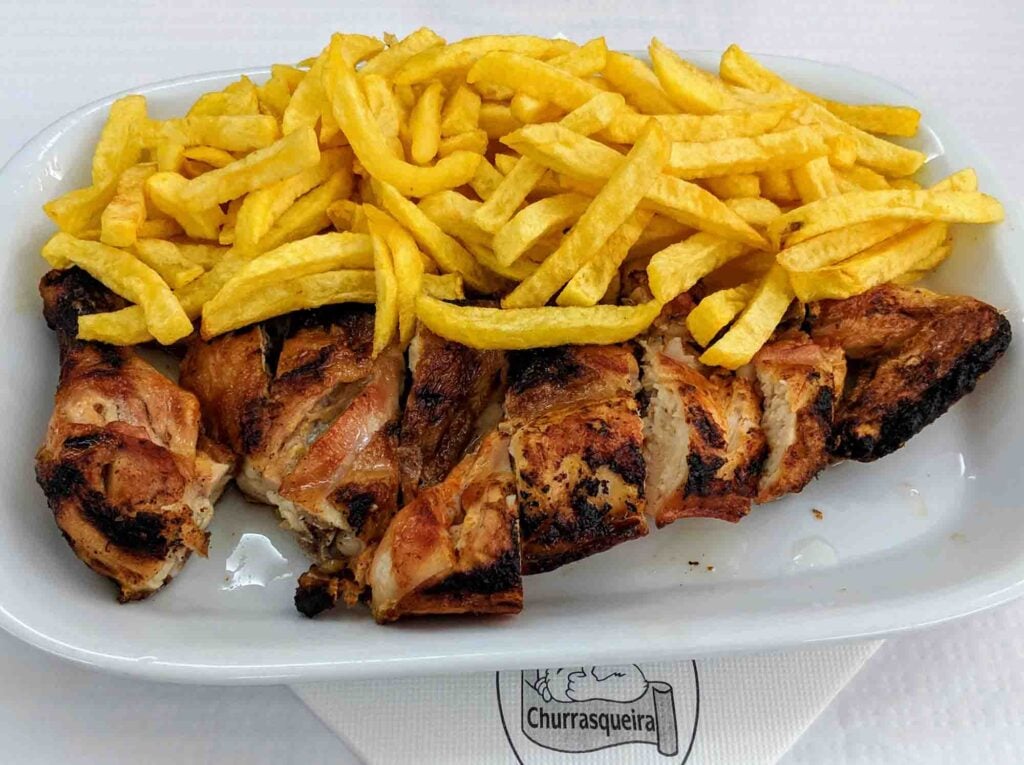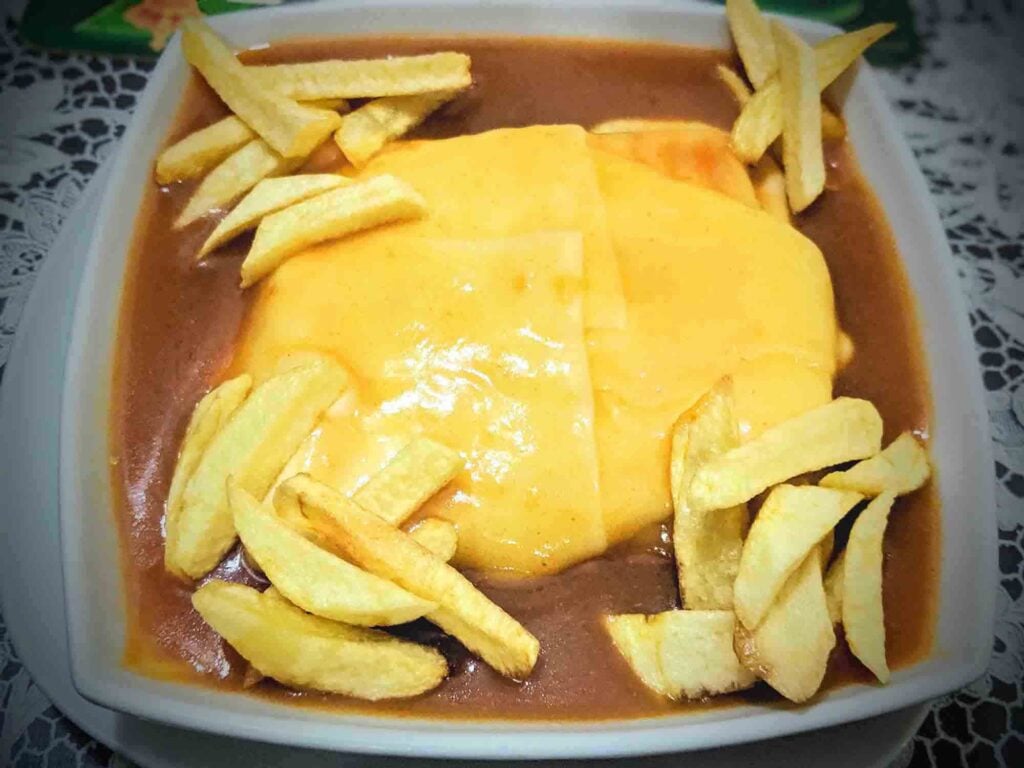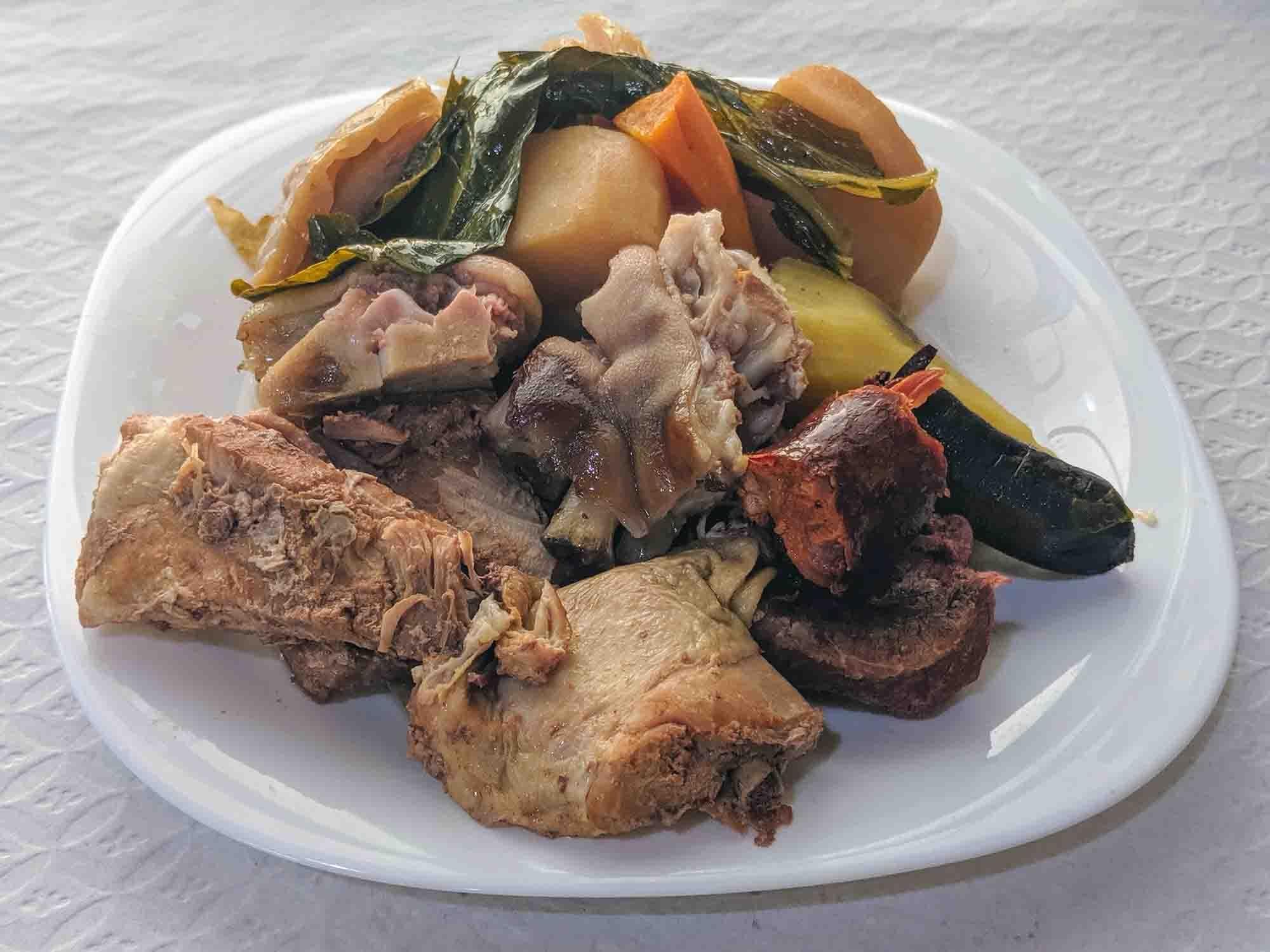As well as fish, the Portuguese have a pronounced affinity for meat, with vegetarianism and veganism not being particularly widespread outside of Lisbon and Porto. This love for meat manifests in an array of traditional Portuguese dishes that can tantalise any palate.
Carne de porco à Alentejana
Alentejo-style pork, also known as pork with clams, is a signature dish in Portuguese cuisine, particularly rooted in the Algarve region. While the former name is recognized nationwide, the latter is favoured in Alentejo itself.
The dish marries clams with pork, seasoned with paprika, bay leaves, wine, and garlic, among other aromatic additions. After frying the meat, it’s combined with the clams and often garnished with coriander. Typically, it’s served alongside diced French fries and a lemon wedge.
This dish holds a special place in Portugal’s culinary scene, with its presence felt in restaurants across the country. Its origin story harks back to the Algarve coast circa 1929. After a beach day, a group of young friends from Estoril and Setúbal combined the day’s catch with available ingredients. The resulting dish – pork fried in olive oil combined with shellfish, topped with diced potatoes and garnished with pickles – caught the attention of one of their parents, who ran “A Alentejana” restaurant. Recognizing its potential, he introduced it to the culinary world, giving it its now-iconic name.
Frango assado com piri-piri

Portuguese barbecue chicken, widely recognized as piri-piri chicken in English-speaking nations, is a beloved dish from Portugal, characterized by its grilled chicken slathered in piri-piri sauce. Typically, it’s paired with fries and salad, though rice is a popular accompaniment in northern Portugal.
The dish’s roots trace back to the Age of Discoveries when Portuguese explorers brought back piri-piri from Mozambique. It’s now a global sensation, with variations found even in Goa, where it’s differentiated from the yellowish-green cafreal chicken.
Frango assado com piri piri, commonly termed as frango assado (roasted chicken), has somewhat elusive origins. Typically made with butterflied chicken marinated in olive oil, seasonings, and piri-piri peppers, the dish is then served with its signature sauce.
This dish shares close ties with an African variant, yet its precise Portuguese origin remains ambiguous. A prevalent theory suggests its emergence in the 1970s when Portuguese expatriates, returning from colonies like Angola and Mozambique, introduced regional ingredients, including the chili essential for the piri-piri sauce. Many of these returnees settled in Algarve, often cited as the dish’s birthplace.
While a staple in Algarve, it’s equally cherished across Portugal, typically served with fries, rice, and a side of tomato salad.
Porco Preto

Portugal has a deep-rooted fondness for pork, with porco preto or black pork sitting atop their preferences. This esteemed pork variety, sourced from the native Iberian pig, boasts a distinct grey to black skin tone, occasionally tinged red.
Renowned for its authentic taste, these pigs predominantly inhabit the Alentejo region, feasting on acorns from cork oak trees. This diet bestows the meat with a unique nutty essence. While the meat from these pigs is fattier than many other varieties, it’s often considered healthier due to the acorn-exclusive diet, likening its fat to the healthy properties of olive oil.
Among the cherished porco preto dishes are:
- Secretos de Porco Preto
- Plumas de Porco Preto
- Mista de Porco Preto
- Lagartos de porco preto
- Bochechas de porco Preto
Leitão da bairrada

Bairrada roast suckling pig, a culinary gem from Portugal’s Bairrada region, has earned its place as one of the country’s 7 Wonders of Gastronomy. While the Romans had a penchant for suckling pig, historical references to it being roasted are scant. The 17th century marked a surge in Bairrada’s pig farming, boosting its prominence in local cuisine.
The earliest known recipe, closely resembling today’s version, dates back to 1743, possibly from the Monastery of Lorvão or the Monastery of Vacariça. Given the sparse records, every Bairrada municipality lays claim to its origin. Known locally as ‘Leitão a Bairrada’, this roasted delicacy is best sampled in the Bairrada wine area, especially Mealhada.
The region’s pigs, primarily acorn-fed, are renowned for their quality. Seasoned with fat, salt, pepper, and garlic, they’re roasted over eucalyptus and vine flames until tender inside with a crispy exterior. The dish is traditionally paired with fried potatoes, orange slices, and a fresh salad. Such is its fame that a dedicated ‘Brotherhood of Leitão da Bairrada’ exists in Portugal.
Alheira

Alheira is a Portuguese sausage traditionally made from various meats, including pork, veal, and poultry, mixed with bread. While its name is derived from “alho” (garlic), not all alheiras today contain garlic, though it remains prevalent.
Many believe these sausages were created by the Jews in Portugal in the 15th century to avoid religious persecution. To make it look like they had converted and now ate pork, they substituted pork with other meats, combined with bread, making a facade of traditional sausages that tasted like a pork sausage.
Originally grilled or roasted and paired with vegetables, modern preparations often involve frying and serving with chips and a fried egg.
While affordable in most restaurants and snack cafes, game-based alheiras can be more expensive. Although most synonymous with Mirandela, Beira Alta and Trás-os-Montes regions are also renowned for their alheiras.
Francesinha

Francesinha, translating to “little French woman”, is a layered sandwich hailing from Porto, Portugal. Stacked with assorted meats like roast, steak, and ham, it’s smothered in a tomato-and-beer sauce and typically accompanied by french fries.
Its inception in the 20th century was inspired by the croque-monsieur. Daniel David de Silva, after his stint in France and Belgium, brought this delicacy to life in 1953 at A Regaleira restaurant in Porto. While quintessentially a Porto dish, Francesinhas are now enjoyed across Portugal, although many would say you have to travel to Porto to get a good one.
Cozido à portuguesa

Cozido à portuguesa is a hearty traditional Portuguese stew, brimming with a medley of vegetables, assorted meats, and distinct sausages. Ingredients often include beans, potatoes, various cuts of pork and beef, and sausages like chorizo and black pudding.
Perfect for the chill of winter, its preparation and ingredient blend slightly differ across regions, though it’s a staple throughout Portugal. It is definitely not for the faint of heart, and you shouldn’t expect to be able to do much after eating it.
While prevalent throughout Portugal, its age-old roots trace back to Areosa in the parish of Pedrouços. In the town of Furnas on the Azorean island of São Miguel, the cozido stew is cooked inside the earth, using heat from the volcano to heat the food.
Cabrito assado no forno
Many people that move to Portugal find themselves missing lamb as this isn’t a meat that’s found in Portuguese supermarkets all year round, usually just around Easter and Christmas. As well as lamb, there’s another meat that makes an appearance at this time and that’s cabrito (young goat).
Roasted goat or lamb is a staple in Portuguese cuisine, particularly during Easter, though it’s relished throughout the year as a cherished Sunday feast. While some may find its robust flavour challenging, the key lies in its meticulous preparation and seasoning. Ideally marinated well in advance, the dish is often paired with roasted potatoes, oven-baked rice, and esparagado. Though the preparation demands effort, the results are unequivocally rewarding.
Clarifying common confusions in Portuguese lexicon around lamb meat: ‘cabrito’ refers to meat from young goats, ‘borrego’ indicates lamb from the sheep lineage, known for its softer, lighter-hued meat, and ‘anho’ describes a matured lamb.
Ensopado de javali
Javali, or wild boar, is a delicacy in Portuguese cuisine, often transformed into a stew named ensopada de javali. This meat carries a distinct and somewhat exotic flavour profile. Notably leaner than common pork, wild boar meat is darker, slightly fibrous, and is believed to have more commendable health attributes, including lower cholesterol, high protein content, and fewer calories.
The versatility of wild boar meat lends itself to a plethora of cooking techniques, be it stewing, roasting, or grilling. However, many Portuguese recipes require you to marinate it at least a day before and then cook it slowly, either as stew on the hob or roasted in the oven. It is normally seasoned with ingredients like garlic, onion, and mint, and left to soak in white wine overnight.


